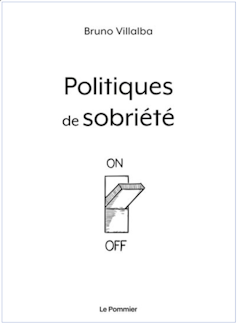
Omnipresent in current debates, sobriety must, in order to face the scale of the ecological and energy crises, become political, underlines political science researcher Bruno Villalba (AgroParisTech) in his book "Politics of sobriety", published at the end of April 2023 by Le Pommier editions . In the excerpt that we invite you to discover below, the author returns to the central notions of materiality, abundance and rarity to decipher the issues of the inevitable adaptation of our freedom to planetary limits.
Sobriety questions our relationship to materiality . It is often conceived as the mass and the physico-chemical composition of the things extracted, produced and exchanged or the investments made which opposes their values .
But such an approach minimizes the available stock, that is to say the physically existing quantity to allow these flow and exchange dynamics to be set up and developed. Conceiving a materiality in an evolutionary vision (such as the extension of the efficient control of exchanges) amounts to maintaining a certain vision of the abundance of the resource – or at least of the extension of its potential for exploitation. However, we are rather witnessing a programmed rarefaction of this materiality. This programming results from the extension of development policies which, inevitably, will lead to the drying up of resources.
Numerous analyzes highlighting this paradox have already been carried out. An abundant literature deals with the programmed disappearance of fossil resources and its catastrophic consequences on our “carbon societies” . We wish to insist on the deployment of even more invisible mechanisms, which makes it more complicated to grasp the relationship of dependence that connects us to them, and to show how much the "peak" concerns almost all the materials with which we maintain an extraction relationship.
In 1863, the chemist Dmitry Mendeleev classified 63 natural chemical elements , known at the time, which make up everything around us, and published, in 1869, the famous "periodic table". Since then, the classification has expanded and there are now 118 listed elements, 90 of which occur in nature. The rest are mostly super heavy elements that have been created in laboratories over the past few decades by nuclear reactions and rapidly decay into one or more of the naturally occurring elements.
In 1976, the American chemist William Sheehan offered a new vision of this painting . It represents each element according to its abundance or its rarity, which makes it possible to escape from the traditional presentation, where each of them is carefully arranged in small equivalent squares18.
We can thus see the abundance of hydrogen (H), carbon (C), oxygen (O), a lesser profusion of phosphorus (P) or calcium (Ca), and a very low presence of lithium (Li) or argon (Ar), or even more, the extreme shortage of promethium (Pm). With this figuration, he wishes to signify the possibilities of exploitation of these elements, according to their natural profusion or their artificial creation. This sketch, taken up and then broadcast on digital networks, is graphically improved; thus, the table has been color coded to indicate the greater or lesser vulnerability of the elements.

To follow environmental issues as closely as possible, find our thematic newsletter “Ici la Terre” every Thursday. Subscribe today .
What is thus staged is the extension of the pressure on certain non-renewable elements. Of course, this synthetic presentation has been the subject of certain criticisms, one of which mentions the absence of global knowledge on the state of the resources which would prevent the degree of disappearance from being accurately measured. But they do not call into question the unequal pressure on resources, nor the intensification of tensions.
The European Chemical Society (EuChemS) is inspired by this work and publishes, in 2021, a new version of its “Element Scarcity – EuChemS Periodic Table” . In most cases, the elements have not disappeared. But, as we use them, they disperse and are much more difficult to recover. Dispersion will make some elements much less readily available in a hundred years or less – this is the case for helium (He), silver (Ag), tellurium (Te), gallium (Ga), germanium (Ge), strontium (Sr), yttrium (Y), zinc (Zn), indium (In), arsenic (As), hafnium (Hf) and tantalum (Ta). Helium is used to cool magnets in MRI scanners and to dilute oxygen for scuba diving. 26 elements of Mendeleïev's table, such as gold, copper, platinum, uranium, zinc or phosphorus would be in the process of exhaustion. 6 others have an expected useful life of less than a hundred years . Of the 90 elements, 31 bear a smartphone symbol – reflecting the fact that they are all contained within these devices.

The European Chemical Society also draws our attention to another dimension, which the authors describe as “coming from the resources of the conflict”. For example, carbon, especially oil, can come from places where wars are fought over oil fields or where oil revenues are used to fight wars. We are therefore faced with a limited stock of constituent elements. Moreover, even the arrangements that we can make between them are limited: when one of the elements is missing, they are not always substitutable.
From this simple material observation, we see how much technological overcoming is rendered illusory because of the gradual disappearance of non-renewable resources . Their rarity should lead to moderation in their use. We thus find the “stock of sand”: a limited quantity, limited possibilities for innovation due to the programmed disappearance of certain elements, as well as limited combinations… And it will still be necessary for future generations to manage these shortages sustainably.
Despite this state of affairs, the ecological transition, particularly in its energy component, continues to promote the development of green technologies requiring the intensive use of these limited resources. It is necessary, whatever the cost, to maintain growth, now flanked by the qualifier "green". According to the Organization for Economic Co-operation and Development (OECD), this growth is “to foster economic growth and development while ensuring that natural assets continue to provide the resources and environmental services on which our well-being depends. To do this, it must catalyze the investment and innovation that will underpin sustainable growth and create new economic opportunities”.
This definition clearly highlights the goal that Western democracies and autocracies seek to achieve today: to pursue economic amplification, but relying on technical progress in an attempt to mitigate environmental impacts.
However, this artefact of classical and neo-classical economists, which supposes considering the economic system as a perpetual motion machine, comes up against the very real material limits of the natural world. Indeed, the reserves of rare metals are relatively scarce, compared to the frenetic rate of consumption of our century. It is growing at a rate of 3 to 5% per year. As an indication, by 2030, the demand for germanium, used for the manufacture of photovoltaic cells, will double; that of tantalum, used as a conductor of heat and electricity or for the manufacture of surgical instruments and implants, will quadruple; that of cobalt, used for the manufacture of magnets or hybrid cars, will be multiplied by 24 . These less abundant metals (lithium, beryllium, cobalt, etc.) have become essential for the production of magnets, motors, batteries, incorporated into electronics, etc. So many resources that are essential for the development of “green energies”. The rare earths – around thirty chemical elements – are also concerned by this intensification of their exploitation, in the name of renewable energies.

Extractivism is general! Depletion is gradual but permanent. The quantity of raw material extracted from the Earth increased from 22 billion tons in 1970 to 70 billion tons in 2010. During the years 2000-2010, on a global scale, between 47 and 49 billion tons of materials were extracted each year, or 18 kg on average per day and per person .
At the current rate of extraction, many are likely to be exhausted in fifty years. It is estimated that to meet the demand – in terms of housing, mobility, food, energy, water, etc. – of the future 10 billion inhabitants of our planet, 180 billion tonnes of raw materials, ie three times the amount of current resources , will be needed by 2050. The deep ocean is thus becoming a new play area for extractivism. We are quietly considering going to exploit the Moon and Mars…: the Poubellocene will become spatial!
It goes without saying that the negative impacts will go hand in hand. First of all, these exploitations respond to the law of extraction peaks: we must dig deeper, for more diffuse concentration rates… Which inevitably leads to a logic of exhaustion and an increase in the growing energy costs of their extraction.
Next, these policies have significant social effects, such as the increase in energy prices due to these quantity contractions, but also the financial speculation they will produce. In addition, we must also take into account the rebound effects on the major ecological issues: to extract ever more matter, we will need ever more resources (oil, water, etc.), which will accentuate greenhouse gas emissions and will participate in the continuity (see amplification) of the feedback effects of climate change (ocean acidification, erosion of biodiversity, etc.), but will also have consequences on living environments, on pollution and eutrophication of soils and fresh water tables, massive deforestation…
Finally, this race for resources will contribute to the increase in violence and local conflicts to protect the wealth generated by these operations. The decrease in available volumes (at low cost) leads to an increase in prices, which makes access more difficult for certain countries that do not have significant financial resources.
If we want to build policies of energy sovereignty at the level of each country, competition will be fierce to secure access to these resources . The concentration of these lands in a few countries represents a major source of geopolitical tension . For example, China today has 80% to 90% of the world's production of 17 materials, essential for the manufacture of many electronic equipment, even though it only has a third of the reserves. How to react to the contraction of trade if China decides to conserve these resources? Resource stocks are increasingly becoming strategic issues, as the war in Ukraine has shown. States are developing strategies to secure their supplies in order to maintain this flow of metals that are essential to the functioning of their economy. How to guarantee the supply of so-called “critical” metals , according to the terminology of the International Energy Agency? The question is asked, the answer is more sibylline, especially when it tends to water down its relationship to violence (securing the resource and thus strengthening its sovereignty) as well as the consequences of a local redeployment of supplies (reducing its dependence means relaunching the exploitation of mines on its soil, which is not without encountering strong opposition).

But in the face of this reality, we continue to invoke the myth of an innovation capable of limiting the rebound effects and of developing restorative compensations… This extractivist policy mobilizes more and more skills and ingenuity, financing and complexities in supply chains – which contributes all the more to the fiction of limitless human ingenuity, as evidenced by the story of “green” energies. ![]()
Bruno Villalba , Professor of environmental political science, AgroParisTech – University of Paris-Saclay
This article is republished from The Conversation under a Creative Commons license. Read the original article .
